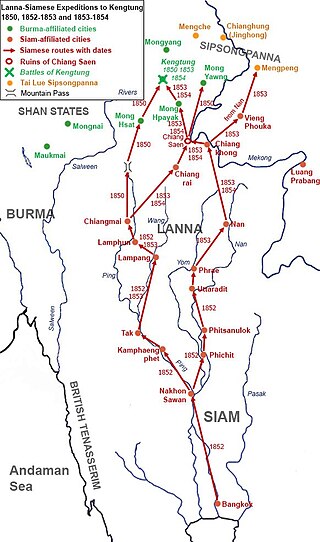Related Research Articles

Evidence of modern human presence in the northern and central highlands of Indochina, which constitute the territories of the modern Laotian nation-state, dates back to the Lower Paleolithic. These earliest human migrants are Australo-Melanesians—associated with the Hoabinhian culture—and have populated the highlands and the interior, less accessible regions of Laos and all of Southeast Asia to this day. The subsequent Austroasiatic and Austronesian marine migration waves affected landlocked Laos only marginally, and direct Chinese and Indian cultural contact had a greater impact on the country.

Chao Anouvong, or regnal name Xaiya Setthathirath V, , led the Lao rebellion (1826–28) against Siam as the last monarch of the Kingdom of Vientiane. Anouvong succeeded the throne in 1805 upon the death of his brother, Chao Inthavong, Xaiya Setthathirath IV, who had succeeded their father, Ong Bun or Phrachao Siribounyasan Xaiya Setthathirath III. Anou was known by his father's regnal number until recently discovered records disclosed that his father and brother had the same regnal name.

Prince Phetsarath Ratanavongsa (Somdej Chao Maha Uparaja Petsaraj Ratanavongsa was the 1st Prime Minister of Luang Phrabang in French Laos from 21 August 1941 to 10 October 1945, and Head of State of Laos between 12 October 1945 and 4 April 1946.

KingZakarine was the king of Luang Prabang from 1895 to 1904.

The French protectorate of Laos was a French protectorate in Southeast Asia of what is today Laos between 1893 and 1953—with a brief interregnum as a Japanese puppet state in 1945—which constituted part of French Indochina. It was established over the Siamese vassal, the Kingdom of Luang Phrabang, following the Franco-Siamese crisis of 1893. It was integrated into French Indochina and in the following years further Siamese vassals, the Principality of Phuan and Kingdom of Champasak, were annexed into it in 1899 and 1904, respectively.

The Thonburi Kingdom was a major Siamese kingdom which existed in Southeast Asia from 1767 to 1782, centered around the city of Thonburi, in Siam or present-day Thailand. The kingdom was founded by Taksin the Great, who reunited Siam following the collapse of the Ayutthaya Kingdom, which saw the country separate into five warring regional states. The Thonburi Kingdom oversaw the rapid reunification and reestablishment of Siam as a preeminient military power within mainland Southeast Asia, overseeing the country's expansion to its greatest territorial extent up to that point in its history, incorporating Lan Na, the Laotian kingdoms, and Cambodia under the Siamese sphere of influence.

The Kingdom of Vientiane was formed in 1707 as a result of the split of the Kingdom of Lan Xang. The kingdom was a Burmese vassal from 1765 to 1779. It then became a Siamese vassal until 1828 when it was annexed by Siam.

The Kingdom of Luang Phrabang, also called Kingdom of Luang Prabang was formed in 1707 as a result of the split of the Kingdom of Lan Xang. When the kingdom split, Muang Phuan became a tributary state of Luang Prabang. Over the years the monarchy weakened even more, and was forced to become a vassal various times to the Burmese and the Siamese monarchies.

The Burmese–Siamese War of 1849–1855 or Siamese Invasions of Kengtung or Kengtung Wars were military expeditions of the Siamese Rattanakosin Kingdom against the Tai Khün State of Kengtung, which had been under Burmese suzerainty under the Konbaung dynasty. The dynastic struggles in Tai Lue State of Chiang Hung or Sipsongpanna prompted Siam, in cooperation with the Kingdom of Lanna, to invade Kengtung in order to gain access to Chiang Hung. In the First Invasion in 1850, the Siamese court had ordered the Lanna Lord of Chiang Mai to organize the offensives against Kengtung. Lanna troops failed to conquer Kengtung. Two other expeditions occurred in 1852 and 1853 as Bangkok commanded its troops to directly participate in the invasions. Both expeditions also failed because of internal issues and geographical unfamiliarity. The State of Kengtung under the leadership of Saopha Maha Khanan, with limited assistance from Burma who had been embroiling in the Second Anglo-Burmese War, managed to resist Siamese-Lanna invasions three times.
Nanthasen, also known as Chao Nan, was the 6th king of the Kingdom of Vientiane. He ruled from 1781 to 1795.
Chao Inthavong, or known as his regnal name Xaiya Setthathirath IV, was the 5th king of the Kingdom of Vientiane.
Chao Ong Kham, also known as Ong Nok, was the king of Luang Phrabang from 1713 to 1723, later the king of Lanna from 1727 to 1769.
Chao Kingkitsarat, also known as Kitsarat or Kitsarath, was the king of Luang Phrabang.
Chao Inthasom was the king of Luang Phrabang from 1723 to 1749.
Chao Inthaphom, also known as his regnal name Intharavongsa, was a king of Luang Phrabang.
Chao Sotikakumman was the king of Luang Phrabang from 1750 to 1771.
Surinyavong II was the king of Luang Phrabang from 1771 to 1788.
Chao Manthaturath was the king of Luang Phrabang from 1819 to 1836.
Chao Sukkhasoem was the king of Luang Phrabang from 1839 to 1850.

Lao–Siamese War or the Siamese Invasion of Laos (1778–1779) is the military conflict between Thonburi Kingdom of Siam and the Lao kingdoms of Vientiane and Champasak. The war resulted in all three Lao kingdoms of Luang Phrabang, Vientiane and Champasak becoming Siamese tributary vassal kingdoms under Siamese suzerainty and domination in Thonburi and the subsequent Rattanakosin Period.
References
- 1 2 3 Stuart-Fox, Martin (2008). History Dictionary of Laos (3rd ed.). Scarecrow Press, Inc. p. 11. ISBN 978-0-8108-5624-0.